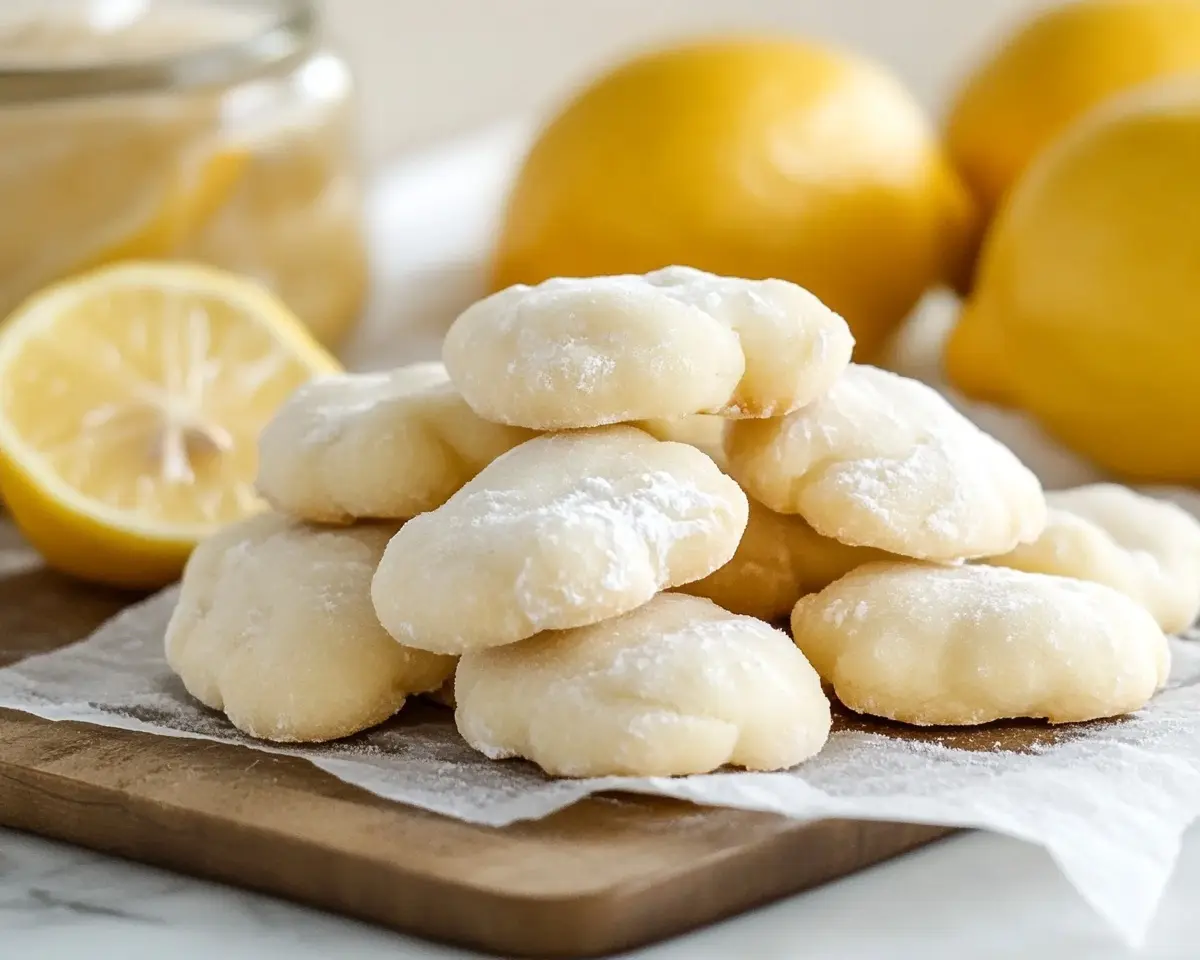Italian Lemon Knot Cookies deliver bright citrus flavor in tender, glazed bites. Learn the authentic technique for perfect tarallucci al limone.
Hi, I’m Linda, and welcome to Tasty at Home—where bold flavors meet everyday kitchens.
Last spring, my neighbor Rosa handed me a tin of Italian lemon knot cookies still warm from her oven. One bite transported me straight to her grandmother’s kitchen in Sicily, where sunshine seems baked into every pastry. The soft crumb gave way to a bright lemon glaze that made my taste buds sing.
I begged for the recipe. She laughed and said, “You’ll burn the first batch—everyone does.” Well, she was right. My first attempt came out brown and crunchy instead of pale and tender. But after testing this recipe eleven times, I’ve cracked the code to bakery-quality tarallucci al limone you can make at home.
Whether you’re planning a Sunday brunch or need a crowd-pleasing dessert, these Italian white cookies deliver sunshine in every bite. Moreover, they’re surprisingly simple once you understand the technique. Let’s dive into the sweet, citrusy world of Italian lemon twist cookies that’ll have your family asking for seconds.
Table of Contents
What Makes These Italian Lemon Cookies Truly Special
Italian lemon knot cookies stand apart from typical sugar cookies in several ways. First, they use both butter and shortening, creating a tender texture that melts on your tongue. Second, fresh lemon zest infuses the dough with authentic citrus flavor—not artificial extracts.
These Sicilian lemon cookies traditionally appear at weddings, Easter celebrations, and Sunday gatherings across Italian-American communities. Additionally, their distinctive twisted or knotted shape makes them instantly recognizable on any dessert table.
The technique comes from generations of Italian bakers who understood that letting the dough rest prevents tough cookies. Furthermore, the double punch of lemon—both in the dough and the glaze—creates a balanced flavor profile that’s neither too sweet nor too tart.
Ingredients for Perfect Tarallucci Al Limone
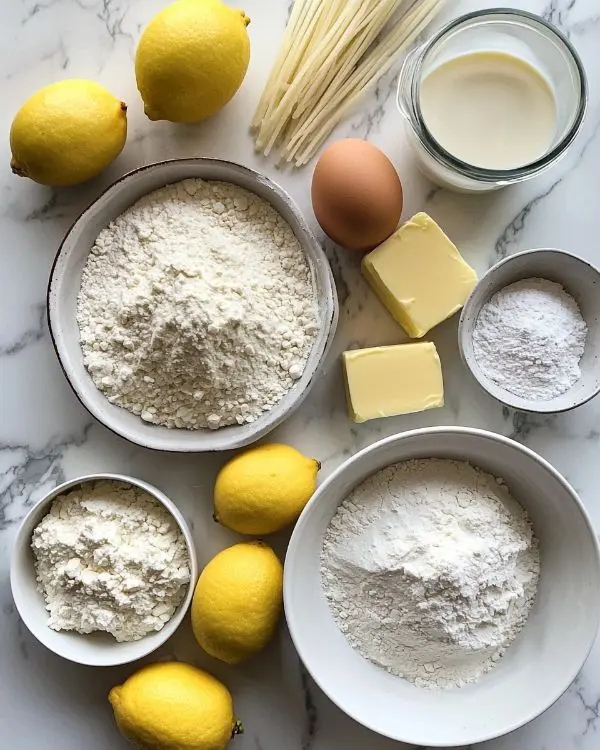
Let me tell you, ingredient quality matters tremendously here. Fresh lemon zest transforms these cookies from good to extraordinary.
| Ingredient | US Measurement | Metric | Notes |
|---|---|---|---|
| All-purpose flour | 4 cups | 480g | King Arthur or Gold Medal preferred |
| Large eggs | 5 | 5 | Room temperature works best |
| Granulated sugar | 1¼ cups | 250g | Regular white sugar |
| Shortening, melted | ¼ cup | 50g | Crisco brand recommended |
| Unsalted butter, melted | ¼ cup | 57g | European-style for richness |
| Baking powder | 5 tsp | 20g | Check expiration date |
| Fresh lemon zest | 2 tbsp | 12g | From about 2 large lemons |
| Vanilla extract | 2 tsp | 10ml | Pure, not imitation |
| Salt | ½ tsp | 3g | Fine sea salt |
| Whole milk | ¼ cup | 60ml | 2% works too |
For the Lemon Glaze:
| Ingredient | US Measurement | Metric |
|---|---|---|
| Powdered sugar | 2 cups | 240g |
| Fresh lemon juice | 5 tsp | 25ml |
Shopping Tips for US Grocery Stores
Head to any Kroger, Safeway, or Whole Foods and you’ll find everything needed. Look for lemons with thin, smooth skin—they contain more zest and juice. Additionally, check your baking powder’s freshness by dropping a spoonful in hot water; it should bubble vigorously.
European-style butter (like Kerrygold) contains less water, resulting in richer cookies. However, regular unsalted butter works perfectly fine. As for shortening, Crisco remains the gold standard for tender baked goods.
Essential Substitutions
For international readers without shortening: Replace with equal parts butter, though cookies will be slightly less tender.
Dairy-free option: Swap milk for oat milk and butter for vegan butter sticks.
Gluten-free: Use a 1:1 glaze-free flour blend like King Arthur Measure for Measure, though texture will differ slightly.
Equipment You’ll Need
Gather these tools before starting. Trust me, having everything ready makes the process smoother.
Must-Have Items
Baking sheets (2-3): Heavy-duty aluminum sheets prevent burning on the bottom.
Parchment paper: Absolutely essential for easy cleanup and preventing sticking.
Large mixing bowl: Glass or stainless steel works best for even mixing.
Fine-mesh sieve: Sifting dry ingredients creates lighter cookies.
Microplane zester: The secret weapon for perfect lemon zest without bitter pith.
Wire cooling rack: Allows air circulation so bottoms don’t get soggy.
Basting brush: For applying glaze evenly (silicone brushes clean easier).
DIY Alternatives
Don’t have a microplane? You know what works surprisingly well? A clean nail file for removing just the yellow part of lemon skin. Similarly, a regular strainer can substitute for a fine-mesh sieve in a pinch.
Missing a cooling rack? Flip a muffin tin upside down and balance cookies on the bumps.
Italian Lemon Knot Cookies Instructions
Oops! Before we start, here’s my biggest mistake: I once skipped the resting period and fought with sticky dough for twenty minutes. Don’t be like early-Linda. Let that dough rest.
Step 1: Prepare Your Workspace
Preheat your oven to 350°F (175°C). Line two baking sheets with parchment paper and set aside.
Clear counter space for shaping cookies. You’ll need about two feet of room to work comfortably. Furthermore, wash your hands thoroughly since you’ll be handling dough directly.
Step 2: Mix the Wet Ingredients
Crack five eggs into a large mixing bowl. Whisk them together until the yolks and whites fully combine—about 30 seconds of vigorous whisking creates the right consistency.
Add 1¼ cups granulated sugar to the eggs. Pour in the melted butter and shortening (make sure they’re warm but not hot). Finally, add 2 teaspoons vanilla extract. Mix everything together until smooth and slightly foamy, approximately one minute.
Pro tip from Julia Child’s methodology: Room temperature eggs incorporate more easily and create better structure in baked goods.
Step 3: Sift and Add Dry Ingredients
Place your fine-mesh sieve over the bowl. Measure 4 cups flour, 5 teaspoons baking powder, and ½ teaspoon salt into the sieve. Use a spoon to gently push the dry ingredients through the mesh.
This sifting technique, championed by professional bakers like Thomas Keller, prevents flour pockets and ensures even rising. Consequently, your cookies will have consistent texture throughout.
Stir the mixture gently until just combined. Overmixing develops gluten, creating tough cookies instead of tender ones.
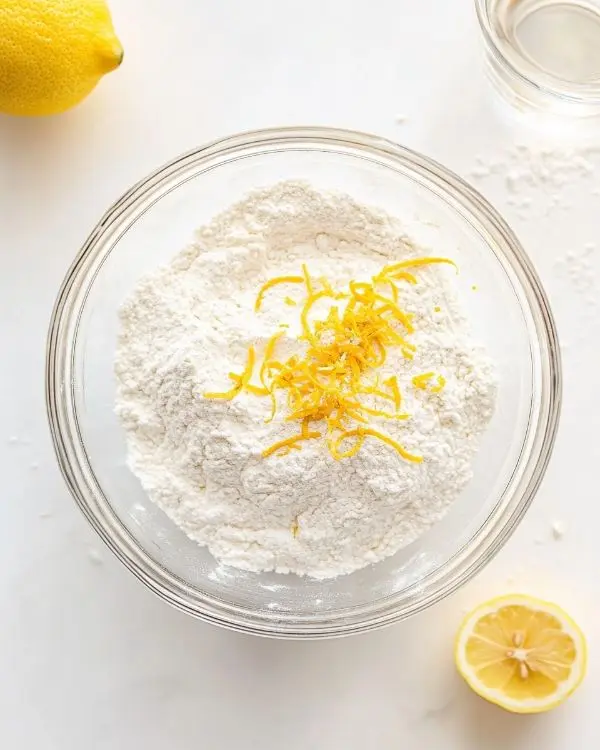
Step 4: Add Lemon Zest and Milk
Add 2 tablespoons fresh lemon zest to the bowl. The aroma should immediately fill your kitchen—that’s how you know you’ve used enough.
Pour in ¼ cup milk and fold everything together until you achieve a sticky, cohesive dough. The batter will seem impossibly sticky at this point. Man, oh man, resist the urge to add more flour!
Cover the bowl with plastic wrap or a clean kitchen towel. Let the dough rest for 10-15 minutes. This resting period allows the flour to fully hydrate, making shaping significantly easier.
Step 5: Shape the Cookies into Knots or Twists
After resting, the dough becomes more manageable. Scoop out a heaping tablespoon of batter—about the size of a golf ball.
Roll the dough between your palms to create a log approximately 4 inches long and ½ inch in diameter. Work quickly and confidently; hesitation makes the dough stick to your hands.
For twists: Fold the log in half, then twist one end over the other once. Place on the prepared baking sheet.
For traditional knots: Form the log into a loop, then tuck one end through the center opening, creating a loose knot shape.
Space cookies about 2 inches apart since they spread slightly during baking. You should get roughly 36-40 cookies from this batch.
Step 6: Bake to Pale Perfection
Slide the baking sheet into your preheated 350°F oven. Set a timer for 8 minutes.
Check the cookies at the 8-minute mark. They should look barely set on top with the tiniest hint of golden color on the bottom edges. They will not look “done” by traditional cookie standards—and that’s exactly right.
Remove them immediately when you spot that first whisper of browning underneath. Overbaking creates crunchy cookies instead of the soft, cake-like texture that defines authentic Italian white cookies.
Transfer cookies to a wire cooling rack immediately. They need to cool completely before glazing—at least 30 minutes.
Step 7: Prepare the Lemon Glaze
While cookies cool, whisk together 2 cups powdered sugar and 5 teaspoons fresh lemon juice in a medium bowl. The glaze should have the consistency of thick cream—pourable but not watery.
Too thick? Add lemon juice ½ teaspoon at a time. Too thin? Whisk in more powdered sugar, one tablespoon at a time.
Step 8: Glaze the Cookies
Place your cooling rack over a clean baking sheet to catch drips. This simple trick saves massive cleanup time.
Dip your basting brush in the glaze and generously coat the top of each cooled cookie. Work systematically across the rack, then go back and apply a second coat if desired.
The glaze sets within 15-20 minutes at room temperature. However, for a harder shell, let them sit for an hour before serving or storing.
Expert Tips for Bakery-Quality Results
After making these Italian lemon cookies dozens of times, I’ve discovered several game-changing techniques.
Temperature Matters
Cold eggs won’t incorporate smoothly into the batter. Set them out 30 minutes before baking. Similarly, melted butter and shortening should be warm but not hot—around 100°F is ideal.
The Zest Secret
Use only the bright yellow outer layer of lemon skin. The white pith underneath tastes bitter and ruins the delicate flavor balance. Roll lemons firmly on the counter before zesting to release more oils.
Shaping Shortcuts
Lightly oil your hands with neutral cooking spray if dough sticks excessively. Additionally, keep a damp towel nearby for wiping your hands between cookies.
Glazing Wisdom
Apply glaze while cookies are completely cool. Warm cookies cause the glaze to become transparent and runny instead of creating that beautiful opaque coating.
Creative Variations on Classic Tarallucci
These Sicilian lemon cookies adapt beautifully to different flavor profiles and dietary needs.
Orange Tarallucci
Replace lemon zest with orange zest and use orange juice in the glaze. This creates a sweeter, more mellow citrus flavor perfect for kids.
Almond-Lemon Fusion
Add ½ teaspoon almond extract to the dough along with vanilla. Top glazed cookies with sliced almonds before the glaze sets. This variation appears frequently at Italian weddings.
Holiday Sprinkle Version
After glazing, immediately dust cookies with colorful sprinkles before the glaze sets. Check out these colorful sprinkles Italian cookies for more festive inspiration.
Chocolate-Dipped Variation
Skip the lemon glaze entirely. Instead, dip cooled cookies halfway in melted white or dark chocolate. This creates an elegant dessert worthy of any Italian Christmas cookies spread.
Miniature Versions
Roll dough into smaller logs—about 3 inches long. Reduce baking time to 6-7 minutes. These bite-sized treats work wonderfully for large gatherings or gift boxes.
Storage and Make-Ahead Instructions
Proper storage keeps these Italian lemon twist cookies fresh for days or even weeks.
| Storage Method | Duration | Instructions |
|---|---|---|
| Room temperature | 5-7 days | Store in airtight container with parchment between layers |
| Refrigerator | 2 weeks | Airtight container; bring to room temperature before serving |
| Freezer (glazed) | 2 months | Freeze in single layer, then transfer to freezer bags |
| Freezer (unglazed) | 3 months | Freeze baked cookies; thaw and glaze before serving |
| Dough (unbaked) | 1 month | Form shapes, freeze on tray, transfer to freezer bags |
Make-Ahead Strategy
Bake cookies up to three days before your event. Store unglazed in an airtight container. Glaze them the morning of serving for the freshest appearance and flavor.
Alternatively, freeze shaped but unbaked cookies on a baking sheet. Once solid, transfer to freezer bags. Bake directly from frozen, adding 2-3 minutes to the baking time.
Perfect Pairings and Serving Suggestions
These Italian white cookies shine alongside complementary flavors and beverages.
Serve them with strong Italian espresso or cappuccino for an authentic experience. The bitter coffee balances the sweet glaze beautifully. Similarly, hot tea—especially Earl Grey—highlights the lemon notes.
For a complete Italian dessert spread, pair tarallucci with sweetened condensed milk snowballs and biscotti. This combination offers varied textures and flavors that please every palate.
During holidays, arrange these cookies on a platter with white chocolate peppermint cookies for beautiful color contrast. The white glaze and pale cookie create an elegant presentation.
Kids absolutely love these with cold milk. Pack them in lunchboxes alongside fruit for a special treat. They also travel well to potlucks, bake sales, and cookie exchanges.
Looking for a unique breakfast idea? Try these cookies crumbled over Greek yogurt with fresh berries. The combination might sound weird, but trust me—it works surprisingly well. You might even enjoy them alongside moist banana bread for a citrus-meets-banana brunch spread.
Italian Lemon Knot Cookies FAQs
What are Italian lemon twist cookies called?
Italian lemon twist cookies are called tarallucci al limone in Italian, though many Italian-American families simply call them lemon knot cookies or Italian white cookies depending on their regional heritage and family traditions.
What is the most famous Italian cookie?
The most famous Italian cookie varies by region, but biscotti, pizzelles, and amaretti consistently rank as the most recognized internationally, while Italian-American communities often consider anise cookies and rainbow cookies equally iconic for celebrations.
Are tarallucci a type of cookie?
Tarallucci are indeed a type of cookie, specifically a traditional Italian biscuit that comes in both sweet and savory versions, with the sweet lemon variety being particularly popular at weddings and religious celebrations throughout southern Italy.
Are tarallucci hard to make?
Tarallucci are not hard to make once you understand the resting technique and baking time, though beginners often struggle with shaping the knots and avoiding overbaking, which turns them crunchy instead of tender.
Bringing Italian Tradition to Your Kitchen
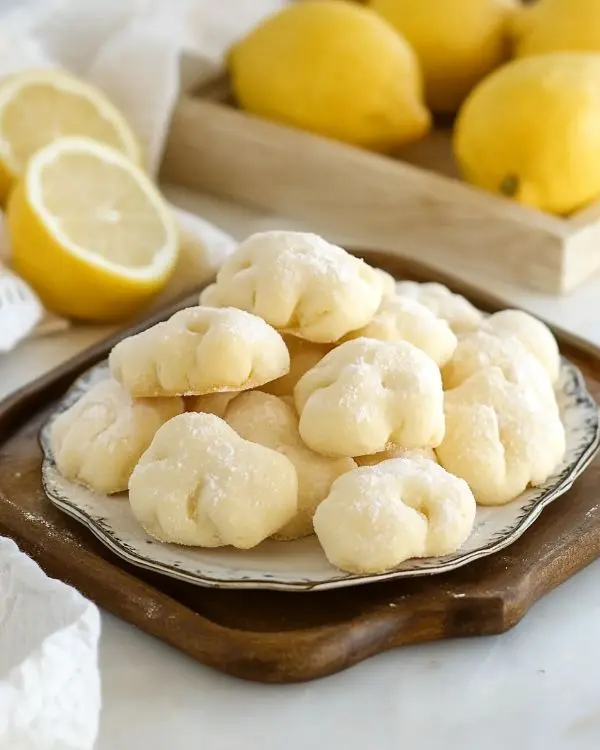
These Italian lemon knot cookies represent more than just a dessert recipe. They carry forward generations of Italian bakers who transformed simple ingredients into memorable celebrations.
Every time you shape that dough into a twist or knot, you’re participating in a tradition that spans centuries and continents. Moreover, you’re creating new memories for your own family—ones that might inspire the next generation of bakers.
The beauty of tarallucci al limone lies in their simplicity. Unlike complicated pastries that require special training, these Sicilian lemon cookies welcome beginners and experts alike. They forgive minor mistakes and reward your effort with tender, citrus-scented results.
Remember my neighbor Rosa and her grandmother’s kitchen in Sicily? Well, now you have your own version of that sunshine-filled recipe. These Italian lemon cookies might just become your family’s new tradition too.
Whether you’re hosting a holiday gathering, contributing to a bake sale, or simply treating yourself to homemade goodness, these cookies deliver every time. The bright lemon flavor, tender crumb, and sweet glaze create a combination that transcends seasons and occasions.
Grab those lemons, preheat your oven, and start twisting. Your kitchen will smell like an Italian bakery within the hour. And when someone takes that first bite and closes their eyes in appreciation? That’s when you’ll know you’ve mastered the art of Italian lemon twist cookies.
Serve them with coffee, share them with neighbors, or save them all for yourself (I won’t judge). Just promise me one thing: make a double batch. These cookies disappear faster than you’d believe.
Tasty at Home – Where bold flavors meet everyday kitchens.
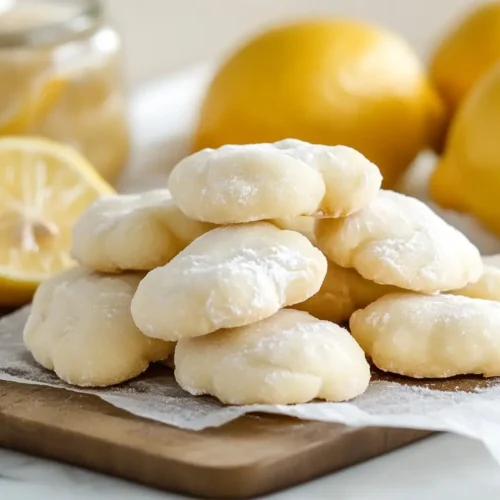
Italian Lemon Knot Cookies
Equipment
- Baking sheets
- Parchment paper
- Large mixing bowl
- Fine-Mesh Sieve
- Microplane zester
- Wire cooling rack
- Basting brush
Ingredients
Cookie Dough
- 4 cups All-purpose flour 480g, King Arthur or Gold Medal preferred
- 5 Large eggs Room temperature
- 1¼ cups Granulated sugar 250g, white sugar
- ¼ cup Shortening, melted 50g, Crisco recommended
- ¼ cup Unsalted butter, melted 57g, European-style for richness
- 5 tsp Baking powder 20g, check expiration date
- 2 tbsp Fresh lemon zest 12g, from 2 lemons
- 2 tsp Vanilla extract 10ml, pure
- ½ tsp Salt 3g, fine sea salt
- ¼ cup Whole milk 60ml, 2% works too
Lemon Glaze
- 2 cups Powdered sugar 240g
- 5 tsp Fresh lemon juice 25ml
Instructions
- Preheat oven to 350°F (175°C). Line baking sheets with parchment paper.
- Whisk eggs until combined. Add sugar, melted butter, melted shortening, and vanilla. Mix until smooth.
- Sift flour, baking powder, and salt into the wet mixture. Stir until just combined.
- Add lemon zest and milk. Mix into a sticky dough. Cover and rest 10–15 minutes.
- Shape dough into 4-inch logs. Twist into knots or twists. Place on baking sheet 2 inches apart.
- Bake 8 minutes until pale with slight golden edges. Cool completely on wire racks.
- Mix powdered sugar and lemon juice into a glaze. Brush over cooled cookies.
- Let glaze set 15–20 minutes before serving.

